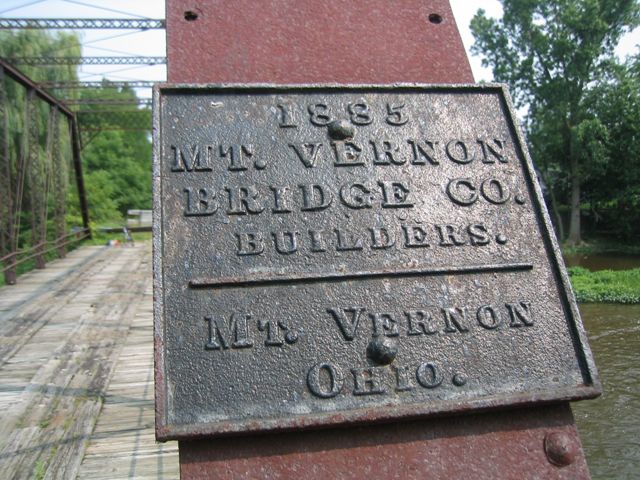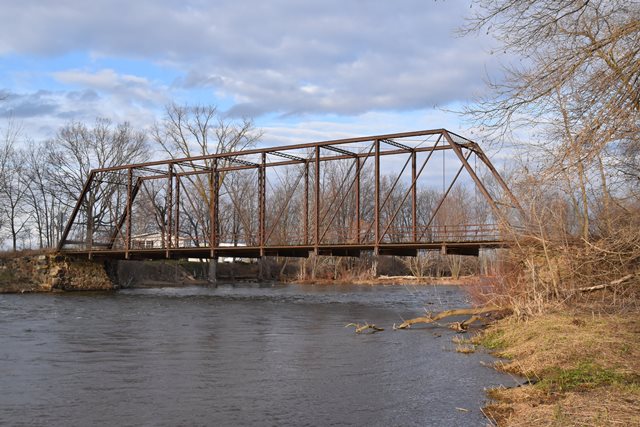We Recommend:
Bach Steel - Experts at historic truss bridge restoration.
Martin Road Bridge
Valley Mills Bridge
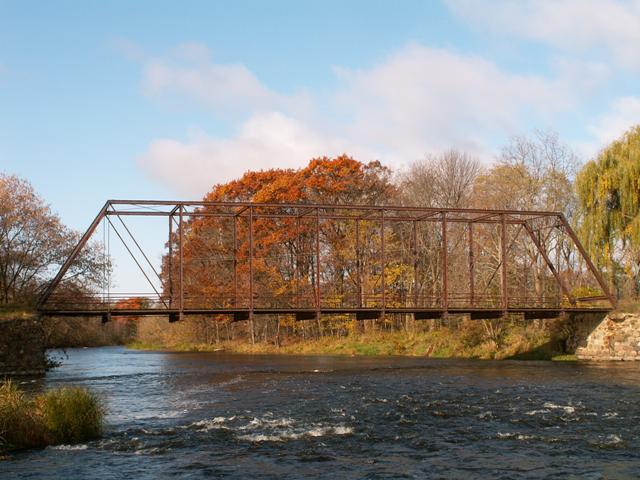
Primary Photographer(s): Nathan Holth
Bridge Documented: 2003-2015
Rural: Shiawassee County, Michigan: United States
1885 By Builder/Contractor: Mount Vernon Bridge Company of Mount Vernon, Ohio
Not Available or Not Applicable
114.8 Feet (35 Meters)
118.8 Feet (36.2 Meters)
15 Feet (4.57 Meters)
1 Main Span(s)
76304H00003B010

View Information About HSR Ratings
Bridge Documentation
This bridge is in storage!
Bridge Status: This historic bridge was dismantled and placed in storage in 2016 and will be restored and relocated to the State of Delaware!View Archived National Bridge Inventory Report - Has Additional Details and Evaluation
2016 Update: Bridge Saved!
As the previous narrative below highlights, efforts to raise awareness of this bridge's crumbling abutments and inspire a preservation solution for this bridge by HistoricBridges.org have gone on for over ten years. With no funding for preservation in place presenting itself, and with the abutments continued deterioration leading to a critical and imminent risk of collapse, the next best preservation success story finally materialized: relocation and reuse in a new location. The nonprofit organization Workin' Bridges successfully advocated for this bridge's restoration and reuse in a special state park being developed in the State of Delaware, an effort which directly saved this bridge from a certain fate of collapse into the Shiawassee River. Disassembly, restoration, and reinstallation in Delaware are being undertaken by Bach Steel.
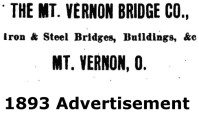
An Extremely Significant Bridge
This nine-panel pin-connected Pratt through truss bridge is one of the oldest surviving metal bridges in Michigan, and is the only example of a bridge built by Mount Vernon Bridge Company in left in Michigan. It is also one of the oldest surviving example's of the company's work in the country. Most surviving Mount Vernon Bridge Company bridges are from the 20th Century. Perhaps the most distinguishing and significant feature of the bridge is its nearly complete lack of alteration: its trusses have near-perfect historic integrity, displaying the same appearance, materials, and design it displayed on the day it was built. Even the railings on the bridge, composed of two angles and among the smallest railings ever encountered, remain in place on the bridge with only a couple sections missing. The trusses themselves display remarkably little section loss and pack rust, meaning that not only has nothing been replaced on the bridge, the original parts that remain are in decent condition such that a restoration project for this bridge would not require the replacement of original material. The bridge also displays built-up floorbeams that are uncommon because among built-up floorbeams the beams are fairly shallow, and one might have expected to have simply seen rolled i-beams for floorbeams of this depth. This is further evidence of the bridge's old construction date. The bridge's lateral bracing connection to the struts and the strut connections to the top chord are somewhat unusual in design. Finally, the hip verticals have an uncommon four-pronged eye detail at the connection to the bottom chord.
A Bridge Looking For A New Home and For Good Reason

A June 2005 visit to this bridge revealed that a section of this bridge's random rubble abutments has completely fallen away. Some stones remain below this section and a couple stones remain above this section, creating a hole in the abutment. The problem is that this hole appears to be below the location of the northeast bearing, which would appear to put this bridge at risk for eventual collapse due to abutment failure, even though as it stands the truss superstructure is in pristine condition. Nothing would be more devastating than to have a metal truss superstructure with such a high degree of historic integrity and no major structural problems destroyed by defective abutments.
Many of Michigan's pre-1910 are noted for having random rubble stone abutments. A far cry from the craftsmanship and quality construction of coursed ashlar abutments found in other states like Pennsylvania, Michigan's random rubble abutments are visually attractive looking, often composed of a variety of colorful stones of various shapes, but they are notoriously unstable due to the random shapes of the stones which rely heavily on mortar to maintain their integrity. They appear to have been constructed using whatever stones builders could find laying around the bridge site and perhaps in nearby farmer's fields. While attractive and a part of Michigan's heritage and identity, the historic significance of these stone abutments is limited and they do not outweigh the value of the metal truss bridge they support. If replacement of such abutments with modern concrete, and/or simply lifting the bridge off of the abutments and placing the bridge into storage is needed to protect the integrity of the truss, than this is what should be done.
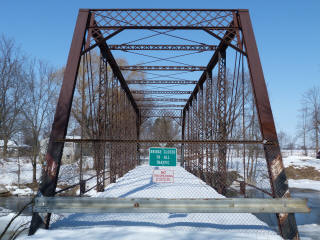
In the case of the Martin Road Bridge, given the serious condition of the abutments contrasted with the excellent condition of the truss superstructure, HistoricBridges.org recommends that the truss should be lifted off of its abutments and placed into storage to await reuse either in a new location or on replacement abutments in its original location. In addition, by 2011, the county road commission had decided to bring an end to allowing visitors to walk on the deck of the bridge and they have installed "No Trespassing" signs and installed cyclone fencing to prohibit access to the bridge. The road commission has indicated they have no intention of spending money to repair and reopen the bridge to pedestrians. However, Shiawassee County Road Commission has indicated a willingness to entertain any proposal to transfer ownership of the bridge to a third party for relocation and preservation. HistoricBridges.org is also happy to assist any interested third party in learning more about the bridge and the potential for any reuse of the bridge. It is assumed that any reuse of this bridge would be for non-motorized traffic. This bridge would make a fantastic and functional centerpiece to any non-motorized trail or path system. HistoricBridges.org may also be able to guide any interested third party to firms that work with historic bridge and likely would be able to restore this bridge to like-new condition for pedestrian use at a cost similar to that of a modern pedestrian bridge.
Note that when the county fenced off the bridge, they also removed the plaques. In the interest of ensuring that these publically owned artifacts from the bridge remained publicly owned (and not part of a road commission employee's private collection) HistoricBridges.org contacted the road commission to inquire about the status of the bridge plaques. The county road commission reports that the plaques are being stored at the county road commission facility. HistoricBridges.org has no objection to this, as the plaques were insecurely mounted to the bridge and at risk for theft. It is presumed that if a third party works out an agreement with the road commission to transfer ownership of the Martin Road Bridge for relocation, preservation, and reuse, that these plaques would also be made available to the third part so that they could be placed on the restored bridge.
About the Martin Road Bridge, From Michigan Historic Sites OnlineNarrative Description: Built in 1885, the Martin Road Bridge is a single-span, pin-connected, Pratt through truss structure, displaying nine panels, with dimensions of 119 feet in length and fifteen feet in width between the trusses. The three-by-eight-inch wooden planks forming the deck are supported by six rows of six-inch I-beams and two rows of six-inch channels carried on sixteen-inch built-up metal floor beams. Rubble fieldstone abutments support the bridge. The structure is currently closed to highway traffic. Statement of Significance: The Martin Road Bridge is one of the oldest metal through truss highway bridges in Michigan. The state's oldest surviving examples date from 1876 and fewer than a dozen such structures built prior to 1890 remain in the entire state. Built in 1885, the bridge is the only surviving through truss highway bridge in Michigan known to have been designed and constructed by the Mt. Vernon Bridge Company of Mt. Vernon, Ohio. The bridge is an excellent and increasingly rare example of late nineteenth-century bridge building. |
This bridge is tagged with the following special condition(s): Available and Unorganized Photos
![]()
Photo Galleries and Videos: Martin Road Bridge
Structure Overview
Original / Full Size PhotosA collection of overview photos that show the bridge as a whole and general areas of the bridge. This gallery offers photos in the highest available resolution and file size in a touch-friendly popup viewer.
Alternatively, Browse Without Using Viewer
![]()
Structure Details
Original / Full Size PhotosA collection of detail photos that document the parts, construction, and condition of the bridge. This gallery offers photos in the highest available resolution and file size in a touch-friendly popup viewer.
Alternatively, Browse Without Using Viewer
![]()
Structure Overview
Mobile Optimized PhotosA collection of overview photos that show the bridge as a whole and general areas of the bridge. This gallery features data-friendly, fast-loading photos in a touch-friendly popup viewer.
Alternatively, Browse Without Using Viewer
![]()
Structure Details
Mobile Optimized PhotosA collection of detail photos that document the parts, construction, and condition of the bridge. This gallery features data-friendly, fast-loading photos in a touch-friendly popup viewer.
Alternatively, Browse Without Using Viewer
![]()
Additional Unorganized Photos
Original / Full Size PhotosA supplemental collection of photos that are from additional visit(s) to the bridge and have not been organized or captioned. This gallery offers photos in the highest available resolution and file size in a touch-friendly popup viewer.
Alternatively, Browse Without Using Viewer
![]()
Additional Unorganized Photos
Mobile Optimized PhotosA supplemental collection of photos that are from additional visit(s) to the bridge and have not been organized or captioned. This gallery features data-friendly, fast-loading photos in a touch-friendly popup viewer.
Alternatively, Browse Without Using Viewer
![]()
Maps and Links: Martin Road Bridge
Coordinates (Latitude, Longitude):
Search For Additional Bridge Listings:
Bridgehunter.com: View listed bridges within 0.5 miles (0.8 kilometers) of this bridge.
Bridgehunter.com: View listed bridges within 10 miles (16 kilometers) of this bridge.
Additional Maps:
Google Streetview (If Available)
GeoHack (Additional Links and Coordinates)
Apple Maps (Via DuckDuckGo Search)
Apple Maps (Apple devices only)
Android: Open Location In Your Map or GPS App
Flickr Gallery (Find Nearby Photos)
Wikimedia Commons (Find Nearby Photos)
Directions Via Sygic For Android
Directions Via Sygic For iOS and Android Dolphin Browser
USGS National Map (United States Only)
Historical USGS Topo Maps (United States Only)
Historic Aerials (United States Only)
CalTopo Maps (United States Only)


